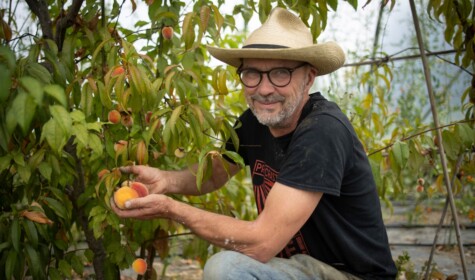As our climate changes, farmers are branching out when it comes to decisions on what they should grow. Here, we look at some crops that might fare well as UK temperatures increase, and consider how these might fit into a more sustainable farming system.
On a farm in West Wales, Nathan Richards (pictured) is beginning to harvest his first small commercial crop of peaches and nectarines. These crops, along with apricots and cherries, are part of an experiment exploring future opportunities for polytunnel-grown stone fruit in the UK. He is interested not only in seeing if these crops are viable in our changing climate, but also trying to make best use of polytunnels’ warmth and vertical space. With the effects of climate change already being felt around the world, farmers like Nathan are increasingly turning their attention to ways that they can adapt, ensuring that they can continue to feed their customers locally grown produce that previously may only have been available on import.
Changes in global temperatures and disruption of regional weather patterns pose a major threat to global food security. Simultaneous harvest failures across major crop-producing regions are increasingly likely, linked to a strongly meandering jet stream which can trigger concurrent extreme weather events. Crops like maize – the primary staple food for many of the world’s people, particularly in lower latitudes – are especially at risk; by the end of the century, it’s possible that maize production could drop by as much as 24% .
Wheat, on the other hand, tends to be grown in more temperate regions and benefits more than maize does from increased concentrations of carbon dioxide in the atmosphere. As a result, wheat production is expected to increase by up to 18% in the same period. These trends highlight the global inequalities of climate change when it comes to impacts on food production, with some staples at greater risk than others.
A recent study looking at sub-Saharan Africa, a region where climate change is compounding difficulties in producing enough food for a fast-growing population, suggests that the answer could lie in crop diversification. Maarten van Zonneveld and his team found that embracing ‘forgotten food crops’, including varieties of leafy vegetables, fruits, cereals, pulses and tubers, could support the ‘double-win’ of more climate-resilient and nutrient-rich food production in the sub-Saharan region.
Choosing crops that will be able to feed us in a changing climate is essential in all of the world’s regions, including here in the UK. Although some predictions show that certain traditional UK-grown staples, like wheat, may have a degree of resilience to climate change, our food supply is far from immune to the shocks of a warming planet particularly given our heavy reliance on foods grown by farmers in other parts of the world.
So, which crops might flourish as we seek to diversify for resilience? Here, we look at four potential candidates.
1. Stone fruit
While plums can flourish in the UK’s temperate climate, other stone fruits, like apricots and nectarines, are more sensitive to weather conditions. Their flowers appear on trees early in the year and are easily damaged by frost, and the fruit needs plenty of sun to ripen. These crops are difficult to produce in more northern latitudes, and they are typically grown in countries such as Turkey, Morocco, Italy and France, and imported to cooler, less sunny countries.
However, there are hopes that these fruits might become easier to grow in countries like the UK as temperatures increase, potentially opening up a new market for farmers and enabling consumers access to fruit that hasn’t been shipped long distances.











